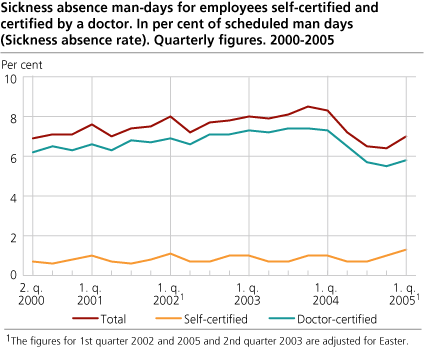Content
Published:
This is an archived release.
Decrease in sickness absence
The total sickness absence fell from 8.3 to 7.1 per cent from the first quarter of 2004 to the first quarter of 2005. Absence certified by a doctor fell from 7.3 to 5.8 per cent, while self-certified absence fell from 1,0 to 1,3 per cent in the same period. We estimate that the sickness absence rate would have been nearly 0.1 percentage point lower in the first quarter of 2005 if Easter like in 2004 had fallen in the second quarter of the year. The figures are taken from the central statistics on sickness absence.
The sickness absence rate for women fell by 1.5 percentage points and the sickness absence rate for men fell by 1.0 percentage point.
The sickness absence rate fell by 15 per cent. The doctor certified sickness absence fell by 21 per cent, while the self-certified sickness absence increased by 22 per cent. The total sickness absence rate fell by 7 per cent compared to the first quarter of 2001, when adjustments due to the fact that Easter fell in the first quarter of 2005, but in the second quarters and 2001 and 2004.
Published tables and further comments are made without adjusting for the effect of Easter.
Decrease in all industries
The strongest decrease among the larger industries was in construction and manufacturing and mining. The sickness absence rate fell from 9.1 to 7.3 per cent in constructions and from 8.5 to 6.9 per cent in construction. Real estate, business activities, public administration and education had the lowest decrease in the sickness absence from the first quarter of 2004 to the first quarter of 2005.
Slow decrease in Troms and Oslo
The sickness absence fell least in Troms it went down form 9.1 to 8.3 per cent, and in Oslo where the sickness absence decreased from 7.5 to 6.8 per cent. Sogn and Fjordane too had a slower decrease than the national average.
Strong decrease in Østfold, Vest-Agder and Telemark
Østfold had the strongest decrease in the sickness absence with a decrease from 9.8 to 7.9 per cent. The sickness absence decreased from 8.5 to 6.8 per cent in Vest-Agder and from 9.2 to 7.4 per cent in Telemark.
Decrease in all institutional sectors
The sickness absence in local government fell from 10.2 to 8.7 per cent from the first quarter of 2004 to the first quarter of 2005. Central government (including the public hospitals) and the private sector had decreases from 7.9 to 6.7 per cent and 7.6 to 6.8 per cent, respectively.
Fall in long-term sickness absence
26,4 per cent of the sickness absence in the first quarter of 2005 stems from doctor-certified cases of sickness absence lasting throughout the quarter. This is a decrease of 4.1 percentage points from the first quarter of 2004.
The sickness absence rate measures man-days lost due to sickness as a proportion of contractual man-days.
Tables:
- Table 1 Sickness absence man-days for employees self-certified and certified by a doctor. In per cent of scheduled man-days (Sickness absence rate). Quarterly figures. 2000-2005
- Table 2 Sickness absence man-days for employees self-certified and certified by a doctor, by sex. In per cent of scheduled man-days (Sickness absence rate). Quarterly figures. 2000-2005
- Table 3 Sickness absence man-days for employees self-certified and certified by a doctor, by industry and type of sickness absence. In per cent of scheduled man days (Sickness absence rate). Quarterly figures. 2000-2005
Contact
-
Arbeidsmarked og lønn
E-mail: arbeidsmarked@ssb.no
-
Unn H. Høydahl
E-mail: unnh.hoydahl@ssb.no
tel.: (+47) 40 90 23 77

